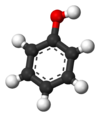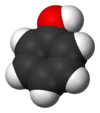Phenol
2008/9 Schools Wikipedia Selection. Related subjects: Chemical compounds
| Phenol | |
|---|---|
| IUPAC name | Phenol |
| Other names | Carbolic Acid Benzenol Phenylic Acid Hydroxybenzene Phenic acid |
| Identifiers | |
| CAS number | [108-95-2] |
| RTECS number | SJ3325000 |
| SMILES | Oc1ccccc1 |
| InChI | 1/C6H6O/c7-6- 4-2-1-3-5-6/h1-5,7H |
| Properties | |
| Molecular formula | C6H5OH |
| Molar mass | 94.11 g/mol |
| Appearance | White Crystalline Solid |
| Density | 1.07 g/cm³ |
| Melting point |
40.5 °C |
| Boiling point |
181.7 °C |
| Solubility in water | 8.3 g/100 ml (20 °C) |
| Acidity (pKa) | 9.95 |
| Dipole moment | 1.7 D |
| Hazards | |
| EU classification | Toxic (T) Muta. Cat. 3 Corrosive (C) |
| NFPA 704 | |
| Flash point | 79 °C |
| Related compounds | |
| Related compounds | Benzenethiol |
| Except where noted otherwise, data are given for materials in their standard state (at 25 °C, 100 kPa) Infobox disclaimer and references |
|
Phenol, also known under an older name of carbolic acid, is a toxic, colourless crystalline solid with a sweet tarry odour. Its chemical formula is C6H5OH and its structure is that of a hydroxyl group (-OH) bonded to a phenyl ring; it is thus an aromatic compound.
Phenols
The word phenol is also used to refer to any compound that contains a six-membered aromatic ring, bonded directly to a hydroxyl group (-OH). In effect, phenols are a class of organic compounds of which the phenol discussed in this article is the simplest member.
Properties
Phenol has a limited solubility in water (8.3 g/100 ml). It is slightly acidic: The phenol molecule has weak tendencies to lose the H+ ion from the hydroxyl group, resulting in the highly water-soluble phenoxide anion C6H5O−. Compared to aliphatic alcohols, phenol shows much higher acidity; it even reacts with aqueous NaOH to lose H+, whereas aliphatic alcohols do not. One explanation for the increased acidity is resonance stabilization of the phenoxide anion by the aromatic ring. In this way, the negative charge on oxygen is shared by the ortho and para carbon atoms. In another explanation, increased acidity is the result of orbital overlap between the oxygen's lone pairs and the aromatic system. In a third, the dominant effect is the induction from the sp² hybridised carbons; the comparatively more powerful inductive withdrawal of electron density that is provided by the sp² system compared to an sp³ system allows for great stabilization of the oxyanion. In making this conclusion, one can examine the pKa of the enol of acetone, which is 10.9 in comparison to phenol with a pKa of 10.0.
Production
Phenol can be made from the partial oxidation of benzene or benzoic acid, by the cumene process, or by the Raschig process. It can also be found as a product of coal oxidation.
Uses
Phenol has antiseptic properties, and was used by Sir Joseph Lister (1827-1912) in his pioneering technique of antiseptic surgery, though the skin irritation caused by continual exposure to phenol eventually led to the substitution of aseptic (germ-free) techniques in surgery. It is also the active ingredient in some oral anesthetics such as Chloraseptic spray. Phenol was also the main ingredient of the Carbolic Smoke Ball, a device sold in London designed to protect the user against influenza and other ailments. In the early part of the 20th century, it was used in the Battle Creek Sanitarium to discourage female masturbation.
It is also used in the production of drugs (it is the starting material in the industrial production of aspirin), herbicides, and synthetic resins ( Bakelite, one of the first synthetic resins to be manufactured, is a polymer of phenol with formaldehyde). Exposure of the skin to concentrated phenol solutions causes chemical burns which may be severe; in laboratories where it is used, it is usually recommended that polyethylene glycol solution is kept available for washing off splashes. Washing with large amounts of plain water (most labs have a safety shower or eye-wash) and removal of contaminated clothing are required, and immediate ER treatment for large splashes; particularly if the phenol is mixed with chloroform (a commonly-used mixture in molecular biology for DNA purification). Notwithstanding the effects of concentrated solutions, it is also used in cosmetic surgery as an exfoliant, to remove layers of dead skin. It is also used in phenolization, a surgical procedure used to treat an ingrown nail, in which it is applied to the toe to prevent regrowth of nails.
Injections of phenol have occasionally been used as a means of rapid execution. In particular, phenol was used as a means of extermination by the Nazis before and during the Second World War. Originally used by the Nazis in the 1930's as part of its euthanasia program, phenol, cheap and easy to make and quickly effective, became the injectable drug of choice on through the last days of the War. Though Zyklon-B pellets were used in the gas chambers when large groups of people needed to be killed, the Nazis learned when smaller groups needed exterminating that it was more economical to inject their victims one at a time with phenol instead. Phenol injections were given to thousands of people in concentration camps, especially at Auschwitz-Birkenau. Injections were administered by medical doctors, their assistants, or sometimes prisoner doctors; such injections were originally given intravenously, more commonly in the arm, but injection directly into the heart, so as to induce nearly instant death, was later preferred . One of the most famous inmates at Auschwitz to be executed by carbolic acid injection was St. Maximilian Kolbe, a Catholic priest who volunteered to undergo three weeks of starvation and dehydration in the place of another inmate and who was finally injected with carbolic acid so that the Nazis could make more room in their holding cells. A use of phenol in molecular biology is the separation of genetic material (nucleic acids) (DNA & RNA) from proteins.
Hydrothermal chemistry
Under laboratory conditions mimicking hydrothermal circulation (water, 200 °C, 1.9 GPa), phenol is found to form from sodium hydrogen carbonate and iron powder (1.8% chemical yield). This discovery made in 2007 may be relevant to the origin of life question as phenol is a fragment of the biomolecule tyrosine. However, as tyrosine is known to result directly from hydroxylation of phenylalanine in modern biological systems, the implications of prebiotic phenol are questionable at best.




